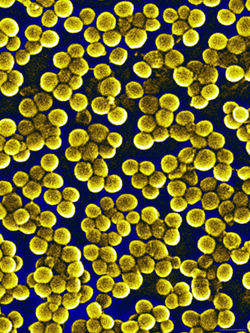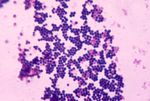Methicillin Resistant Staphylococcus Aureus (MRSA): Difference between revisions
| Line 36: | Line 36: | ||
==Clinical features== | ==Clinical features== | ||
===Symptoms=== | ===Symptoms=== | ||
<i>S. aureus</i> can cause a whole host of different diseases and symptoms depending on where the infection is occurring in the body. The most well known Staph infection is that of the skin, but many other diseases are also caused by Staph infections as well. | |||
====Bacteremia==== | |||
====Endocarditis==== | |||
====Soft tissue infections==== | |||
====Pneumonia==== | |||
====Bone/joint infections==== | |||
====CNS==== | |||
====Toxic Shock Syndrome==== | |||
===Morbidity and Mortality=== | ===Morbidity and Mortality=== | ||
Revision as of 16:16, 23 July 2013

Etiology/Bacteriology
Taxonomy
| Domain = Bacteria | Phylum = Firmicutes | Class = Bacilli | Order = Bacillales | Family = Staphylococcaceae | Genus = Staphylococcus | species = S. aureus
|
NCBI: Taxonomy Genome: Staphylococcus aureus |
Description

Staphylococcus aureus is a Gram-positive, non-spore forming, nonmotile, cocci bacterium that colonizes in yellow clusters. This facultative anaerobe is considered natural flora in 20-30% of humans, living in the anterior nares and on the skin and was first isolated in the 1890’s from the pus from a surgical abscess in a knee joint. S. aureus is the most common type of staphylococci to cause infections because of its ability to evade the immune system and many antibiotics. These “Staph infections” can cause bacteremia, endocarditis, soft tissue infections, pneumonia, bone and joint infections, CNS, toxic shock syndrome, and even food poisoning. The most notorious strain of Staphylococcus aureus was identified in the 1960's and is known as the methicillin resistant strain, commonly known for causing mild to severe skin infections resulting in death if not treated promptly. The most common place to contract Methicillin Resistant Staphylococcus aureus (MRSA) infection is typically in a hospital, but community outbreaks during the past decade have been widely observed, leading scientists to distinguish between Hospital-acquired Methicillin Resistant Staphylococcus Aureus (MRSA) and Community-Acquired Methicillin-Resistant Staphylococcus Aureus (CA-MRSA).
Pathogenesis
Transmission
Since S. aureus are a part of the natural flora in many humans’ nose and mouths, especially humans working in hospitals, the transmission of these bacteria can be difficult to prevent. Because the bacterium is nonmotile, S. aureus is most commonly spread through human-to-human contact or through contaminated surfaces./foods MRSA is typically spread from human-to-human by the hands. In a few cases MRSA can be transmitted through the cough of someone infected with MRSA pneumonia. This bacterium is most commonly transmitted horizontally rather than vertically.
Infectious dose, incubation, and colonization
S. aureus naturally colonizes in many parts of the body such as the nose, mouth, mammary glands, hair, upper respiratory tract and more. In most cases, S. aureus colonize these parts of the body harmlessly. These bacteria can survive in a wide range of temperatures ranging from 15-45 degrees Celsius and can also colonize in NaCl concentrations up to 15%. When ingested, the infectious dose of S. aureus is greater than 100,000 organisms, and the incubation period ranges from 30 minutes to 8 hours. The infectious dose and incubation period for other types of S. aureus infections can be hard to determine, as the bacteria can be carried for unknown amounts of time before causing infection, sometimes months. S. aureus can also be carried both chronically and intermittently.
Epidemiology
Virulence factors
Clinical features
Symptoms
S. aureus can cause a whole host of different diseases and symptoms depending on where the infection is occurring in the body. The most well known Staph infection is that of the skin, but many other diseases are also caused by Staph infections as well.
Bacteremia
Endocarditis
Soft tissue infections
Pneumonia
Bone/joint infections
CNS
Toxic Shock Syndrome
Morbidity and Mortality
Diagnosis
Treatment
Prevention
Immune Response
Host Response
Bacterial Evasion
References
Created by Dehra McGuire, student of Tyrrell Conway at the University of Oklahoma.
